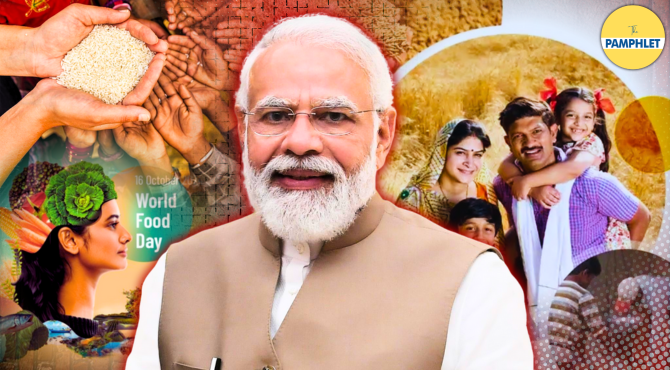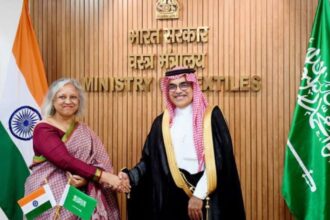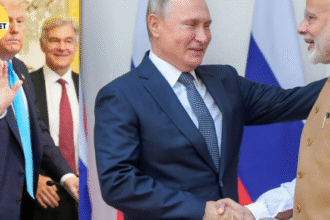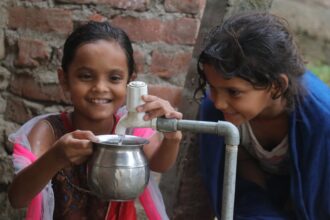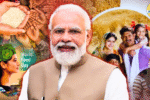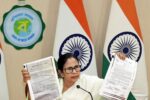Remember the iconic scene from Anil Kapoor’s Nayak– the ration shop owner is exposed for his corruption, skimming off poor people’s ration. Two decades later, that “system” stands transformed. What was once a symbol of inefficiency and theft has become the world’s largest food distribution network — a logistical and moral triumph that feeds 80 crore Indians every month.
On this World Food Day (October 16), as the world debates hunger, nutrition, and rights, India quietly demonstrates what most nations still theorize: that food security is not charity, it is responsibility.
The scale of India’s food security revolution
Prime Minister Narendra Modi’s Pradhan Mantri Garib Kalyan Anna Yojana (PMGKAY) has redefined the architecture of public food welfare.
Extended for five years from January 2024, the scheme now provides free food grains — rice, wheat, and millets — to over 813 million citizens through a network of more than 500,000 Fair Price Shops across India.
The scale dwarfs any comparable initiative in the world. No other country — not the United States, not China, not the European Union combined — delivers food assistance to such a vast segment of its population with this level of regularity and digital precision.
The program builds on the National Food Security Act (NFSA), but PMGKAY expanded it dramatically in scope and reach. Under the scheme, the poorest families receive 35 kilograms of food grains every month, while priority households receive 5 kilograms per person, entirely free of cost.
Beyond free food: Shielding the poor from global inflation
Critics often see PMGKAY as an expensive welfare program. In truth, it is a macroeconomic shield — a stabilizer that has protected India’s poorest citizens from the inflationary storms that have battered much of the world.
When the Russia–Ukraine war disrupted global grain and oil supplies, several countries saw food inflation touch 10–12%. In contrast, India’s retail inflation for 2024–25 averaged 4.6%, the lowest in several years. Food inflation in March 2025 stood at just 3.34% — a remarkable outcome in a volatile global market.
The Ministry of Finance credits PMGKAY and buffer stock management for softening retail prices and easing household pressure. By ensuring a steady, free supply of grains to 800 million people, the scheme reduced market demand spikes, stabilized retail prices, and preserved real income for low-income families.
Even the Reserve Bank of India and the United Nations have acknowledged that free food distribution under PMGKAY absorbed the real impact of inflation. It may distort conventional inflation data — since zero-cost food is not counted in price indices — but on the ground, it made a real difference: the poor were protected, and hunger-driven distress was prevented.
From corruption to credibility: Technology as the game-changer
The transformation of India’s food distribution network is not just about quantity — it’s about credibility. For decades, India’s ration system was synonymous with leaks, ghost beneficiaries, and diversion of grains. The reforms under the Modi government changed that equation completely.
Today, no food grain leaves the system without fingerprint verification and Aadhaar authentication. This has virtually eliminated leakages that once plagued the public distribution system.
The result? The ration card — once a symbol of corruption — has become a certificate of trust. From ghapla to gaurav, as the Hindi saying now goes, India’s food system has traveled the full circle.
Building the world’s food infrastructure
PMGKAY is not an isolated welfare scheme; it represents the public face of a larger transformation in the food ecosystem. Over the past decade, India has invested heavily in creating long-term food resilience — from Mega Food Parks and Integrated Cold Chains to Modern Storage Silos and 100% FDI in Food Processing.
In 2024, the government launched the world’s largest grain storage plan in the cooperative sector, building warehouses and silos across rural India. This is designed to cut post-harvest losses, reduce middlemen, and ensure farmers get better returns while consumers get a secure supply.
At the same time, agri-reforms, digital procurement, and infrastructure modernization have turned India from a food-deficient nation to a food-surplus exporter — capable not just of feeding its citizens but contributing to global food security as well.
World Food Day: India’s quiet answer
World Food Day often witnesses grand speeches and global resolutions — but India’s example offers a grounded truth. Food security cannot rest solely on international aid or abstract goals. It must be built on national will, local logistics, and digital transparency.
Once described as a “ship-to-mouth nation,” dependent on imported grain, India today represents the opposite. It feeds more people than any other government on Earth — and does so with accountability and dignity.
As the Prime Minister said recently, “India’s approach to food is not about politics; it’s about pride.” The free grain that reaches a farmer’s family in Bihar, a worker in Maharashtra, or a widow in Assam is not charity — it is the manifestation of a state fulfilling its moral and constitutional duty.
On this World Food Day, while many nations write slogans about “Zero Hunger,” India quietly writes a success story. What began as a promise during a pandemic has evolved into a permanent pillar of social security.
Once, hunger was India’s weakness; today, food has become its policy. Once, ration meant corruption; today, it represents compassion — and competence.
In a world of rising prices, disrupted supply chains, and uncertain futures, India’s food revolution stands as a reminder that governance, when grounded in integrity and vision, can turn scarcity into security — and survival into dignity.

